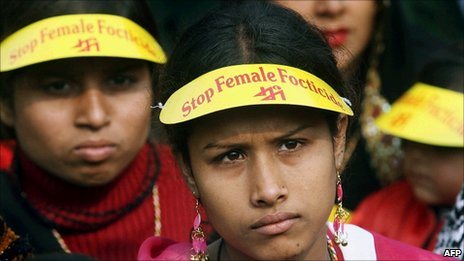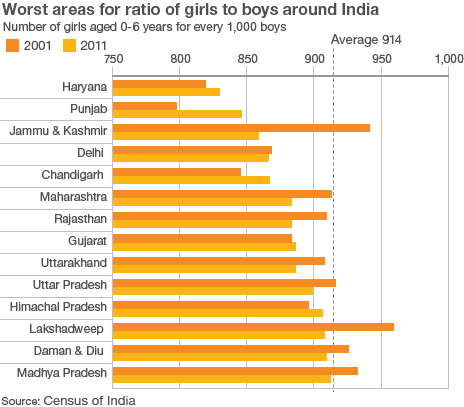Gender selection with a marked preference for male children has been a major problem in India and some other countries. It has resulted in severely skewed male/female ratios in some parts of India with major repercussions as a shortage in the number of eligible young females has caused social unrest in these locations and the need to find eligible young women from other parts of India where the ratios are not as skewed.
The graphic below shows the extent to which these ratios are skewed because of gender selection which occurs mainly through the abortion of female fetuses. It shows the worst offenders among states in India where the greatest distortions are occurring in the number of female to male children aged up to six years.
The Indian government passed legislation making gender selection illegal but from a practical standpoint it has had limited effect. So the problem continues to wreak havoc in the social fabric especially in some parts of North India. The normal ratio of male to female births is 105 males to 100 females and interestingly in the states of Kerala and Andhra Pradesh, the ratio of births is at the normal level.
 There have been limited efforts to educate or “shock” people in some of the states that are the worst offenders as depicted in the image of a young Sikh boy holding a banner with a shocking statistic.
There have been limited efforts to educate or “shock” people in some of the states that are the worst offenders as depicted in the image of a young Sikh boy holding a banner with a shocking statistic.
One of the assumptions has always been that this is something that is prevalent among the less educated and affluent population in these countries. So it was a bit of a revelation to me when I saw a recent article in the Washington Post, that shows that gender selection resulting in the abortion of female fetuses is prevalent even among doctors in India.
The study was limited to physicians who graduated from a specific medical school in Nagpur in India but there is no reason to believe that the results would be substantially different among physicians in other parts of India. The findings of this study were quite remarkable:
“The analysis of information from 946 families, in which either one or both of the parents are doctors, revealed that the female sex ratio is as alarmingly low as 907 to 1000, much below the national average.
“Even more telling was that, among the doctor-headed families with two children in which the first child was female, the average female sex ratio of the second child plunged to 519. But if the first child in the family was male, then the sex ratio of the next child was “marginally in favor of females”, the report said. This suggests that the families might be even more likely to use sex-selective methods if their first child is a girl.”
However, unlike India, abortions for reasons of gender selection is legal in the US and the pro-choice movement which includes many prominent feminists have opposed making it illegals lest it open the door to further restrictions on a woman’s right to choose.
It is the advent of ultrasounds that enables sex-selection and the problem of gender selection extends to other countries besides India.
An article in Science Daily stated:
“The sex ratio at birth in some cities in South Korea climbed to 125 by 1992 and is over 130 in several Chinese provinces from Henan in the north to Hainan in the south.
“In 2005 in China, “it was estimated that 1.1 million excess males were born across the country and that the number of males under the age of 20 years exceeded the number of females by around 32 million,” writes Professor Therese Hesketh, UCL Centre for International Health and Development, London, United Kingdom with coauthors.
“In India, similar disparities exist, with sex ratios as high as 125 in Punjab, Delhi and Gujarat in the north but normal sex ratios of 105 in the southern and eastern states of Kerala and Andhra Pradesh.
“A consistent pattern in all three countries is the marked trend related to birth order and the influence of the sex of the preceding child,” state the authors. If the first or second born are girls, couples will often sex select to ensure the second or third child is a boy.
“The societal implications mean that a significant percentage of the male population will not be able to marry or have children because of a scarcity of women. In China, 94% of unmarried people aged 28 to 49 are male, 97% of whom have not completed high school, and there are worries the inability to marry will result in psychological issues and possibly increased violence and crime.”
Remarkably, this preference for male children rears its ugly head even among Asian immigrants in the US … many are among the most educated and affluent socio-economic groups in the US. A study conducted by the University of California in San Francisco revealed the following:
“Researchers interviewed 65 immigrant Indian women in California, New Jersey and New York who pursued fetal sex selection between September 2004 and December 2009. This qualitative study found not only that 40 percent of the women terminated prior pregnancies when they found the fetus was female, but that, of the women who discovered they were pregnant with a girl during the interview period, 89 percent underwent an abortion. These results were consistent among all education levels; approximately half the women interviewed held jobs outside the home.
“In addition, women who carried a female fetus to term said they were subject to varying degrees of verbal and physical abuse.
“The women came from various religious and educational backgrounds. Thirty eight had finished high school, 12 had graduated from college and 15 held advanced degrees in medicine, law, business, nursing and scientific research.”
This is not a problem limited to Indian immigrants. Another study that focused on Indians as well as other Asian immigrants noted:
“A new study in Proceedings of the National Academy of Sciences reports on a sex ratio that favors boys among U.S.-born children in Indian, Korean, and Chinese families. Using the 1990 and 2000 decennial censuses, the study found that the ratio of male to female births is much higher if the first child is a girl and even higher, by as much as 50 percent, if the first two children are girls. The normal ratio of males to females at birth is 1.05:1. However, if the first child is a girl, the ratio increases to 1.17:1, and if the first and second children are girls, the ratio increases more dramatically to 1.51:1 in favor of boys. The authors note that this is not evident with white parents and that the trend among the base group was not evident in the 1990 census.
“The phenomenon is not unique to Asian immigrants in North America. In 2007, an Oxford University study suggested a similar phenomenon among Indian-born mothers in both England and Wales. It found that the proportion of male to female newborns increased from 103 male births per 100 female births in the 1970s to 114.4 by the end of 2005.”
I have no doubt that the second generation of Indians who are born and brought up in the US and other countries in the West will not adopt the prejudices of their parents who as adult immigrants brought with them the cultural biases they grew up with. I am less sure as to what it will take for there to be a change in attitude on this issue in India and other countries in Asia.
Tags: doctors in India and gender selection, female infanticide in China and South Korea, female infanticide in India, gender selection among Indian and Asian immigrants to the US, gender selection in North India







I rarely comment, but after reading through a few of the remarks
here Physician heal thyself